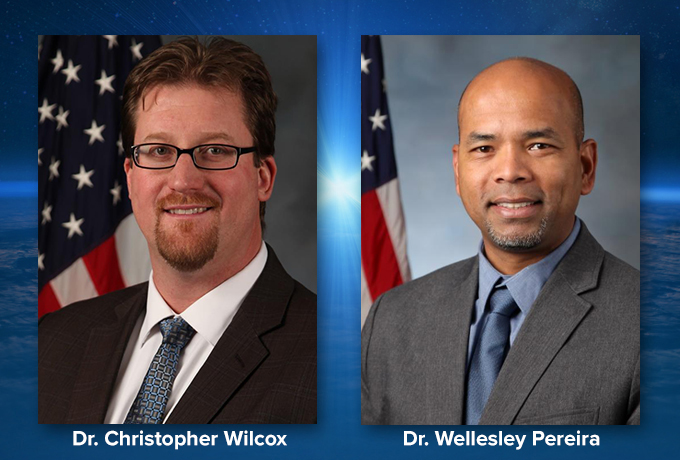AFRL Researchers Honored by SPIE Society
KIRTLAND AIR FORCE BASE, N.M. – Recently SPIE, the international society for optics and photonics, welcomed 72 new Fellows of the society, including the Air Force Research Laboratory’s Drs. Wellesley Pereira and Christopher Wilcox.

They are being recognized for their significant scientific and technical achievements as well as for their service to the optics community and to SPIE.
Pereira began working at the AFRL Space Vehicles Directorate in 2011. He received his Ph.D. in Physics from Michigan Technological University in 2003, of which he says, “My years as a grad student were the seminal years of my life, because that time spent working on building an astronomical sensor that was later deployed at observatories around the world, and my experience there with a wonderful astrophysics team, served as very sound preparation, that launched my career in space technology.” Pereira later worked for a DoD contractor for more than five years before joining federal service.
Pereira said it means a lot to him to be named a Fellow of SPIE. “This is a tremendous honor, and I’m very humbled by it. Being recognized by SPIE for my accomplishments means that all my years of dedicated hard work with research and publications in both open and closed literature, service to SPIE and the community, a volunteer science fair judge, SPIE session chair, or journal associate editor, have been acknowledged by a Society that values technical and service contributions. This award encourages me to continue to pursue science and technology for both military and civilian applications.”
“Like most researchers, I wanted to work at an institution where I could make a difference, while growing as a person and in my career field,” said Pereira. “As an internationally renowned research facility, AFRL has offered me opportunities to be involved in high impact, innovative, and cutting edge technology. It has provided me the ability to work with industry, academia, the Department of Defense, and other national labs, but most of all, it’s the satisfaction and enjoyment of working both technically and professionally with a team of extremely smart and talented people.”
When asked about a career highlight Pereira relates the following.
“The single biggest highlight of my career was seeing my project fly in space. As the principal investigator, I spent several years leading and working with an outstanding team of AFRL and contractor personnel in developing this sensor, so was nervous when it sat on the pad at Cape Canaveral waiting to be launched on an Atlas V. Watching it finally shoot to orbit was an exhilarating experience, but knowing that it eventually worked as designed, was a tremendous sigh of relief that made it all worth the years of rigor that included proposal-writing, benchtop and field testing, building and calibrating, data analysis, and presentations.”
The second SPIE Fellow, Christopher Wilcox was born in Marseille, France where his father was employed as a university professor. As a young boy, his family moved to Albuquerque, N.M. He graduated from the New Mexico Institute of Mining and Technology in Socorro, N.M. with a Bachelor of Science in Electrical Engineering. During his time in Socorro, he also worked at the Karl G. Jansky Very Large Array for the National Radio Astronomy Observatory. Wilcox followed this with a Master of Science Degree in Electrical and Computer Engineering and a Doctorate in Engineering, both from the University of New Mexico.
Following 15 years of federal service with the Naval Research Laboratory, in 2018, Wilcox joined AFRL, where he is an electrical engineer with the Directed Energy Directorate. His research areas include optics, adaptive optics, aero-optics, mathematical modeling, and hardware interfacing and control, which involves use of computers or electronic systems to interface with devices to collect data.
Wilcox has supported SPIE in several capacities and currently serves as chair of the SPIE Information Technologies Committee.
“Being recognized as a Fellow of SPIE is the culmination of the last 16 years of work, ever since I finished my undergraduate degree, started grad school, and began working in the field of optics,” said Wilcox. “Over the years, I have had the opportunity to publish dozens of papers as first author, been co-author on nearly 100 papers, and have two government patents to my name. For SPIE, I have chaired over a dozen technical conference sessions and been involved in several committees to help shape the society for the next generation of researchers. This recognition makes me feel that all of this work is appreciated and has been useful to SPIE and the scientific community, as a whole.”
“AFRL offers me the opportunity to do cutting edge research and allows me to push my capabilities to the limit with respect to engineering,” said Wilcox. “It’s a great environment to work and perform research.”
Wilcox relates a special moment in his career.
“Many years ago, a colleague of mine and I were performing some low-altitude laser propagation experiments over the sea, off of an island near Puerto Rico. We set up a transmitter at a hotel dock and a receiver on a docked boat. We dealt with leaks, power failures, and all-night campaigns collecting data. We didn’t know if we would be successful in the least. However, with our hard work and determination, we collected the data and continued our work with atmospheric characterization with the goal of developing high-speed optical communication links from ship-to-shore/shore-to-ship scenarios. Field work is always very exciting and can be completely unpredictable.”
The Society will recognize Pereira and Wilcox as Fellows of SPIE at the SPIE Photonics West conference that will take place in San Francisco, Calif. in early Feb.
